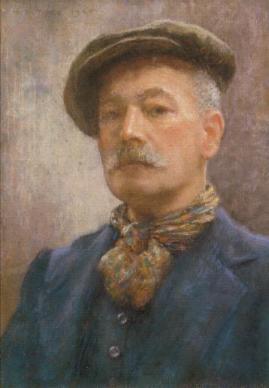Difference between revisions of "Henry Scott Tuke"
From LGBT Archive
Ross Burgess (Talk | contribs) (Created page with "Tuke in 1920'''Henry scott Tuke''' (1858–1929) was a painter, associated with the Newlyn School...") |
Ross Burgess (Talk | contribs) |
||
| (12 intermediate revisions by the same user not shown) | |||
| Line 1: | Line 1: | ||
| − | [[File:Tuke, Henry Scott (1858–1929) - 1920 - Self portrait.jpg|thumb| | + | [[File:Tuke, Henry Scott (1858–1929) - 1920 - Self portrait.jpg|thumb|Self-portrain, 1920]]'''Henry scott Tuke''' (1858–1929) was a painter, associated with the Newlyn School. His paintings are mainly in an impressionistic style, and many of them depict nude young men on the beach or in boats. |
| − | Tuke was born in [[York]], but the family moved to [[Falmouth]] in 1859. Tuke attended a Quaker school in [[ | + | Tuke was born in [[York]], but the family moved to [[Falmouth]] in 1859. Tuke attended a Quaker school in [[Weston-super-Mare]] and then studied at the [[Slade School of Art]] and in Paris. In 1883 he moved to [[Newlyn]], joining an artists' colony, but in 1885 he moved to [[Swanpool]] near Falmouth where he converted a fishing boat into a floating studio and living quarters. |
| + | |||
| + | in 1914 he was elected to the Royal Academy. | ||
| + | |||
| + | [[Charles Kains Jackson]] dedicated a homoerotic sonnet to Tuke. | ||
{{stub}} | {{stub}} | ||
| + | |||
| + | ==Further reading== | ||
| + | ''The life and work of Henry Scott Tuke 1858–1929'' by [[Emmanuel Cooper]]. [[GMP publications]], 1988. Paperback edition by Éditions Aubrey Walter, 1997. ISBN 0-85449-068-X. | ||
| + | |||
| + | ==Gallery== | ||
| + | <gallery> | ||
| + | File:Henry Scott Tuke - A Holiday, 1921.jpg|A holiday, 1921 | ||
| + | File:Tuke, Henry Scott (1858–1929) - 1922 - Lovers of the sun (Midsummer Morning).jpg|Lovers of the sun (Midsummer Morning) 1922 | ||
| + | File:Tuke, Henry Scott (1858–1929), "August Blue," 1893.jpg|August Blue 1893 | ||
| + | File:Tuke, Henry Scott (1858–1929), Ruby, gold and malachite, 1902.jpg|Ruby, gold and malachite 1902 | ||
| + | File:Henry Scott Tuke - T. E. Lawrence as a cadet at Newporth Beach, near Falmouth.jpg|[[T E Lawrence]] as a cadet at Newporth Beach, near [[Falmouth]] | ||
| + | File:Tuke - Frank Hird - a comission for Lord Ronald Gower - colored chalks (29 x 24 cm.), 1894.jpg|[[Frank Hird]], painted for [[Lord Ronald Gower]] | ||
| + | File:Henry Scott Tuke - A full-rigged three-master making ready to sail.jpg|A full-rigged three-master making ready to sail | ||
| + | </gallery> | ||
[[Category:Painters]] | [[Category:Painters]] | ||
| + | [[Category:1858 births]] | ||
| + | [[Category:1929 deaths]] | ||
Latest revision as of 13:19, 10 April 2016
Henry scott Tuke (1858–1929) was a painter, associated with the Newlyn School. His paintings are mainly in an impressionistic style, and many of them depict nude young men on the beach or in boats.Tuke was born in York, but the family moved to Falmouth in 1859. Tuke attended a Quaker school in Weston-super-Mare and then studied at the Slade School of Art and in Paris. In 1883 he moved to Newlyn, joining an artists' colony, but in 1885 he moved to Swanpool near Falmouth where he converted a fishing boat into a floating studio and living quarters.
in 1914 he was elected to the Royal Academy.
Charles Kains Jackson dedicated a homoerotic sonnet to Tuke.
- This article is a stub. You can help the UK LGBT History Project by expanding it.
Further reading
The life and work of Henry Scott Tuke 1858–1929 by Emmanuel Cooper. GMP publications, 1988. Paperback edition by Éditions Aubrey Walter, 1997. ISBN 0-85449-068-X.
Gallery
T E Lawrence as a cadet at Newporth Beach, near Falmouth
Frank Hird, painted for Lord Ronald Gower







